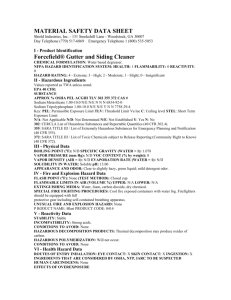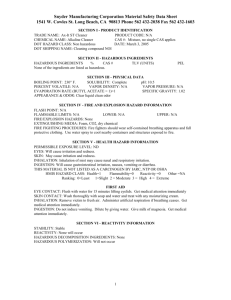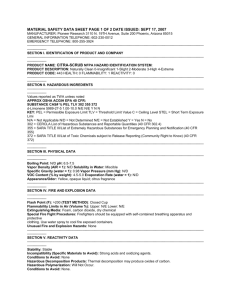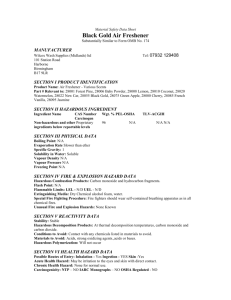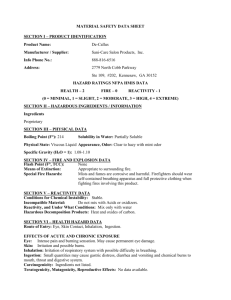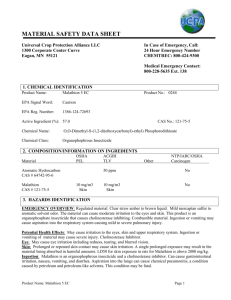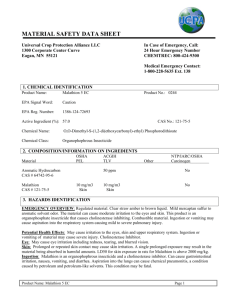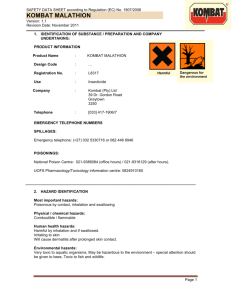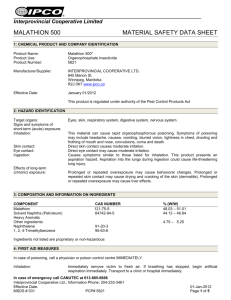green light malathion
advertisement
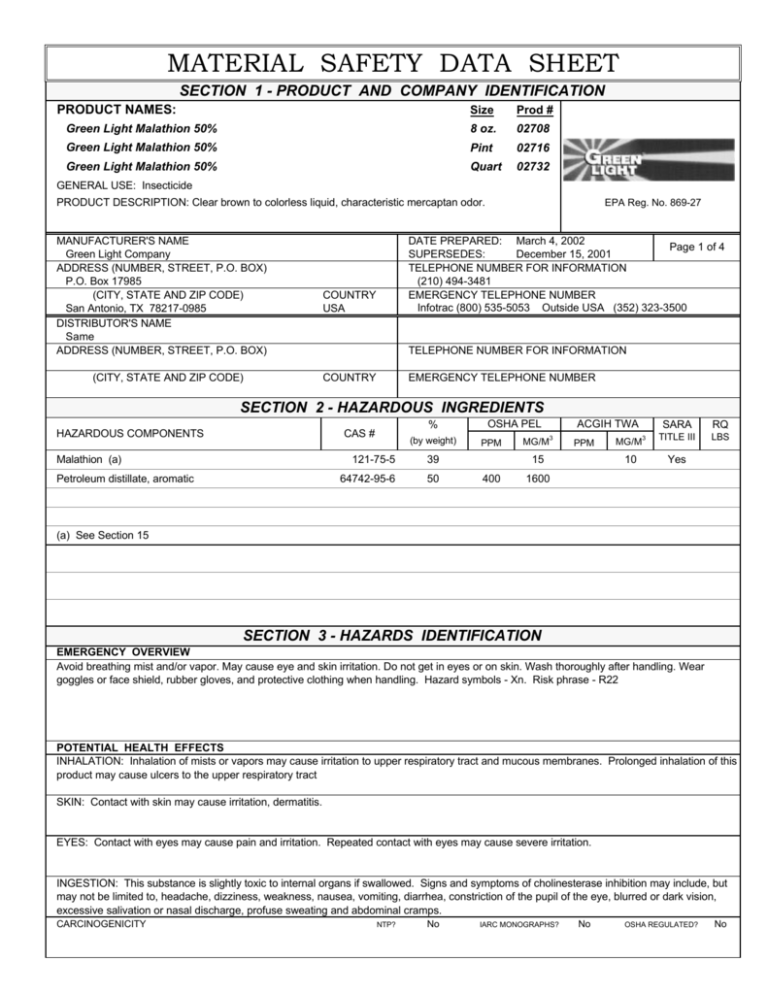
MATERIAL SAFETY DATA SHEET SECTION 1 - PRODUCT AND COMPANY IDENTIFICATION PRODUCT NAMES: Size Prod # Green Light Malathion 50% 8 oz. 02708 Green Light Malathion 50% Pint 02716 Green Light Malathion 50% Quart 02732 GENERAL USE: Insecticide EPA Reg. No. 869-27 PRODUCT DESCRIPTION: Clear brown to colorless liquid, characteristic mercaptan odor. MANUFACTURER'S NAME Green Light Company ADDRESS (NUMBER, STREET, P.O. BOX) P.O. Box 17985 (CITY, STATE AND ZIP CODE) San Antonio, TX 78217-0985 DISTRIBUTOR'S NAME Same ADDRESS (NUMBER, STREET, P.O. BOX) (CITY, STATE AND ZIP CODE) DATE PREPARED: March 4, 2002 Page 1 of 4 December 15, 2001 SUPERSEDES: TELEPHONE NUMBER FOR INFORMATION (210) 494-3481 EMERGENCY TELEPHONE NUMBER Infotrac (800) 535-5053 Outside USA (352) 323-3500 COUNTRY USA TELEPHONE NUMBER FOR INFORMATION COUNTRY EMERGENCY TELEPHONE NUMBER SECTION 2 - HAZARDOUS INGREDIENTS HAZARDOUS COMPONENTS % CAS # Malathion (a) Petroleum distillate, aromatic (by weight) 121-75-5 39 64742-95-6 50 OSHA PEL PPM MG/M3 ACGIH TWA PPM 15 400 SARA RQ MG/M3 TITLE III LBS 10 Yes 1600 (a) See Section 15 SECTION 3 - HAZARDS IDENTIFICATION EMERGENCY OVERVIEW Avoid breathing mist and/or vapor. May cause eye and skin irritation. Do not get in eyes or on skin. Wash thoroughly after handling. Wear goggles or face shield, rubber gloves, and protective clothing when handling. Hazard symbols - Xn. Risk phrase - R22 POTENTIAL HEALTH EFFECTS INHALATION: Inhalation of mists or vapors may cause irritation to upper respiratory tract and mucous membranes. Prolonged inhalation of this product may cause ulcers to the upper respiratory tract SKIN: Contact with skin may cause irritation, dermatitis. EYES: Contact with eyes may cause pain and irritation. Repeated contact with eyes may cause severe irritation. INGESTION: This substance is slightly toxic to internal organs if swallowed. Signs and symptoms of cholinesterase inhibition may include, but may not be limited to, headache, dizziness, weakness, nausea, vomiting, diarrhea, constriction of the pupil of the eye, blurred or dark vision, excessive salivation or nasal discharge, profuse sweating and abdominal cramps. CARCINOGENICITY NTP? No IARC MONOGRAPHS? No OSHA REGULATED? No MATERIAL SAFETY DATA SHEET PRODUCT NAMES: Green Light Malathion 50% March 4, 2002 Page 2 of 4 SECTION 4 - FIRST AID MEASURES INHALATION: Remove affected person to fresh air; wash mouth and nasal passages with water repeatedly; if breathing difficulties persist seek medical attention. SKIN: Wash contacted area with soap and water; DO NOT attempt to neutralize with chemical agents; if irritation persists, seek medical attention. EYES: Remove contact lenses. Immediately flush eyes for 15 minutes in clear running water while holding eyelids open; seek medical attention immediately. INGESTION: If swallowed, call a physician of Poison Control Center immediately. Drink 1 or 2 glasses of water or milk. Do not induce vomiting unless directed to do so by medical personnel. Do not give anything by mouth to an unconscious or convulsing person. SECTION 5 - FIRE FIGHTING MEASURES FLAMMABLE LIMITS FLASH POINT (METHOD USED) LEL: 1.0% UEL: 6.0% AUTOIGNITION TEMPERATURE: Not determined NFPA CLASS: II 167° F (75º C) TCC GENERAL HAZARDS: Product is considered combustible. Products of combustion include compounds of carbon, hydrogen and oxygen, including carbon monoxide. EXTINGUISHING MEDIA Carbon dioxide, water fog, dry chemical, chemical foam FIRE FIGHTING PROCEDURES Firefighters must wear full facepiece self - contained breathing apparatus in positive pressure mode. Do not use solid stream of water since stream will scatter and spread fire. Fine water spray can be used to keep fire - exposed containers cool. UNUSUAL FIRE AND EXPLOSION HAZARDS Closed containers can explode due to buildup of pressure when exposed to extreme heat. Do not use direct stream of water on pool fires as product may reignite on water surface. Caution - Material is combustible! HAZARDOUS COMBUSTION PRODUCTS Smoke, toxic fumes, oxides of carbon SECTION 6 - ENVIRONMENTAL RELEASE MEASURES STEPS TO BE TAKEN IN CASE MATERIAL IS RELEASED OR SPILLED: COMBUSTIBLE - Evacuate and ventilate area; remove all sources of sparks, ignition and open flames; confine and absorb into approved absorbent; place material into approved containers for disposal; do not wash to sewer or waterway. Refer to SARA Title III, Section 313 40 CFR 372 for detailed instructions concerning reporting requirements. Do not discharge into lakes, ponds, streams or public waters. SECTION 7 - HANDLING AND STORAGE PRECAUTIONS TO BE TAKEN IN HANDLING AND STORAGE: This material is combustible. It should be stored in tightly closed containers in a cool, well ventilated area. Vapor may form explosive mixtures in air. All sources of ignition should be controlled. This material may be classified as COMBUSTIBLE by DOT unless transported by vessel or aircraft. Refer to 49 CFR 173.120. Keep this and other chemicals out of reach of children. Avoid inhaling concentrated fumes or vapors. SECTION 8 - EXPOSURE CONTROLS / PERSONAL PROTECTION ENGINEERING CONTROLS The use of local exhaust ventilation is recommended to control emissions near the source. Provide mechanical ventilation of confined spaces. Use explosion-proof ventilation equipment. See Section 2 for Component Exposure Guidelines. PERSONAL PROTECTION: RESPIRATORY PROTECTION (SPECIFY TYPE): None required while threshold limits are kept below maximum allowable concentrations; if TWA exceeds standard workplace limits, NIOSH approved respirator must be worn. Refer to 29 CFR 1910.134 or European Standard EN 149 for complete regulations. PROTECTIVE GLOVES: Neoprene or rubber gloves with cuffs. EYE PROTECTION: Protective eyeglasses or chemical safety goggles as described in 29 CFR 1910.133 or European Standard EN166. OTHER PROTECTIVE CLOTHING OR EQUIPMENT: Coveralls, apron, or other equipment should be worn to minimize skin contact. WORK / HYGIENIC PRACTICES: Practice safe workplace habits. Minimize body contact with this, as well as all chemicals in general. MATERIAL SAFETY DATA SHEET PRODUCT NAMES: Green Light Malathion 50% March 4, 2002 Page 3 of 4 SECTION 9 - PHYSICAL AND CHEMICAL PROPERTIES VAPOR PRESSURE (MM Hg) 2.6 mm Hg @ 20 ° C SPECIFIC GRAVITY (WATER = 1) 1.055 SOLUBILITY IN WATER Negligible pH 6.5 BOILING POINT 312° F (156° C) VISCOSITY Not determined VAPOR DENSITY (AIR = 1) >1 EVAPORATION RATE (WATER = 1) <1 FREEZING POINT Not determined APPEARANCE AND ODOR Clear brown to colorless liquid, characteristic mercaptan odor. PHYSICAL STATE Liquid VOLATILE ORGANIC COMPOUNDS (Total VOC's) 3.4 lbs / gallon SECTION 10 - STABILITY AND REACTIVITY STABILITY CONDITIONS TO AVOID: Extreme temperatures, open flames UNSTABLE: STABLE: XXX INCOMPATIBILITY (MATERIALS TO AVOID): Strong oxidizers, strong acids HAZARDOUS DECOMPOSITION OR BYPRODUCTS: Decomposition will not occur if handled and stored properly. In case of a fire, oxides of carbon, hydrocarbons, fumes, and smoke may be produced. HAZARDOUS POLYMERIZATION CONDITIONS TO AVOID: Polymerization may occur at temperatures above 100º C MAY OCCUR: XXX WILL NOT OCCUR: SECTION 11 - TOXICOLOGICAL INFORMATION Hazardous Ingredients % CAS # Malathion (a) 39 121-75-5 Petroleum distillate, aromatic 50 64742-95-6 LD50 of Ingredient (Specify Species and Route) LC50 of Ingredient (Specify Species) 2314 mg / kg Oral - rat Not determined > 5.2 mg / l / 4H Inhalation - rat Not determined SECTION 12 - ECOLOGICAL INFORMATION This pesticide is toxic to fish, aquatic invertebrates, and aquatic life stages of amphibians. Do not apply directly to water. Drift and runoff may be hazardous to aquatic organisms in areas near the application site. Do not contaminate water when disposing of equipment washwaters. This product is highly toxic to bees exposed to direct treatment on blooming crops or weeds. Do not apply this product or allow it to drift to blooming crops or weeds if bees are visiting the treatment area. SECTION 13 - DISPOSAL CONSIDERATIONS WASTE DISPOSAL METHOD: Dispose of in accordance with Local, State, and Federal Regulations. This product may produce concentrated hazardous vapors or fumes in a disposal container creating a dangerous environment. Refer to "40 CFR Protection of Environment Parts 260 299" for complete waste disposal regulations for ignitable materials. Consult your local, state, or Federal Environmental Protection Agency before disposing of any chemicals. Do not flush to sanitary sewer or waterway. SECTION 14 - TRANSPORT INFORMATION PROPER SHIPPING NAME: Environmentally Hazardous Substances, Liquid, N.O.S., (Malathion) HAZARD CLASS / Pack Group: REFERENCE: UN / NA IDENTIFICATION NUMBER: HAZARD SYMBOLS: 9 / III 49 CFR 172 UN 3082 G IATA HAZARD CLASS / Pack Group: IMDG HAZARD CLASS: RID/ADR Dangerous Goods Code: UN TDG Class / Pack Group: 9 / III Marine Pollutant 9 9 / III Note: Transportation information provided is for reference only. Client is urged to consult CFR 49 parts 100 - 177, IMDG, IATA, EC, Canadian TDG, and United Nations TDG information manuals for detailed regulations and exceptions covering specific container sizes, packaging materials and methods of shipping. MATERIAL SAFETY DATA SHEET PRODUCT NAMES: Green Light Malathion 50% March 4, 2002 Page 4 of 4 SECTION 15 - REGULATORY INFORMATION TSCA (Toxic Substance Control Act) Components of this product are listed on the TSCA Inventory. SARA TITLE III (Superfund Amendments and Reauthorization Act) 311/312 Hazard Categories Health, acute, chronic 313 Reportable Ingredients: (a) Indicates a toxic chemical subject to annual reporting requirements of Section 313 of SARA Title III of the Emergency Planning and Community Right-To-Know Act of 1986 and of 40 CFR 372. CERCLA (Comprehensive Response Compensation and Liability Act) None EPA (Environmental Protection Agency) Use of this product is regulated by the U.S. Environmental Protection Agency (EPA) through the approved label copy. It is a violation of Federal law to use this product in a manner inconsistent with its labeling. CPR (Canadian Controlled Products Regulations) This product has been classified in accordance with the hazard criteria of the Controlled Products Regulations and the MSDS contains all the information required by the Controlled Products Regulations IDL (Canadian Ingredient Disclosure List) Components of this product identified by CAS number and listed on the Canadian Ingredient Disclosure List are shown in Section 2. DSL / NDSL (Canadian Domestic Substances List / Non-Domestic Substances List) Components of this product identified by CAS number are listed on the DSL or NDSL and may or may not be listed in Section 2 of this document. Only ingredients classified as "hazardous" are listed in Section 2 unless otherwise indicated. EINECS (European Inventory of Existing Commercial Chemical Substances) Components of this product identified by CAS numbers are on the European Inventory of Existing Commercial Chemical Substances. EC Risk Phrases R22 Harmful if swallowed EC Safety Phrases S2 Keep out of the reach of children. S24 Avoid contact with skin. S25 Avoid contact with eyes. SECTION 16 - OTHER INFORMATION No specific notes HEALTH FLAMMABILITY REACTIVITY HMIS HAZARD RATINGS PERSONAL PROTECTIVE EQUIPMENT REVISION SUMMARY: This MSDS has been revised in the following sections: MSDS Prepared by: Section 14 Section 15 2 2 0 0 = INSIGNIFICANT 1 = SLIGHT 2 = MODERATE C Safety Glasses, Gloves, Apron 3 = HIGH 4 = EXTREME Transportation information WHMIS DSL / NDSL information Comprehensive Data Base, Inc. P.O. Box 5604 Lakeland, FL 33807 USA (863) 644 - 3298 www.compdatabase.com The information contained herein is believed to be accurate but is not warranted to be so. Data and calculations are based on information furnished by the manufacturer of the product and manufacturers of the components of the product. Users are advised to confirm in advance of need that information is current, applicable and suited to the circumstances of use. Vendor assumes no responsibility for injury to vendee or third persons proximately caused by the material if reasonable safety procedures are not adhered to as stipulated in the data sheet. Furthermore, vendor assumes no responsibility for injury caused by abnormal use of this material even if reasonable safety procedures are followed. Any questions regarding this product should be directed to the manufacturer of the product as described in Section 1.

